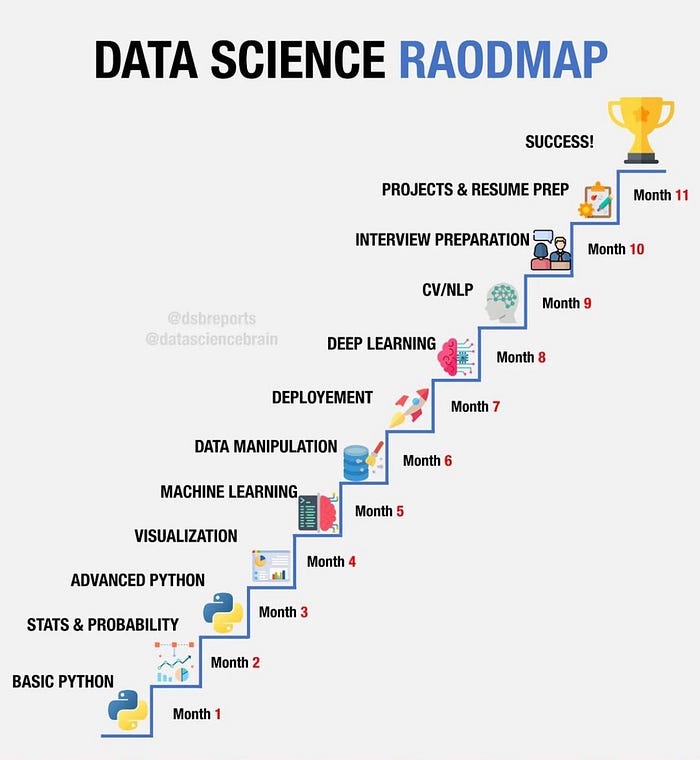In today’s data-driven world, the demand for skilled data scientists is soaring. Python, with its versatile libraries and powerful data manipulation capabilities, has become the go-to language for data science. If you’re a beginner aspiring to become a data scientist using Python, this roadmap will guide you through the essential steps to kickstart your journey.

- Learn the Fundamentals of Python: To start your data science journey, it’s crucial to have a solid foundation in Python programming. Begin by learning the basics of Python syntax, data types, control flow, and functions. Online platforms like Codecademy, Coursera, and Udemy offer comprehensive Python courses for beginners.
- Understand Mathematics and Statistics: Data science heavily relies on mathematical and statistical concepts. Familiarize yourself with core topics such as linear algebra, calculus, probability, and statistics. These subjects form the backbone of many data science algorithms and models. Resources like Khan Academy, MIT OpenCourseWare, and online textbooks are excellent places to start.
- Dive into Data Manipulation and Analysis: Python provides several powerful libraries for data manipulation and analysis, such as NumPy, Pandas, and Matplotlib. Learn how to manipulate arrays and perform operations using NumPy. Explore Pandas to handle tabular data, clean datasets, and perform exploratory data analysis (EDA). Matplotlib will help you visualize your data effectively.
- Master Data Visualization: Visualizing data is crucial for understanding patterns and communicating insights effectively. Beyond Matplotlib, explore advanced visualization libraries like Seaborn and Plotly. These libraries offer enhanced interactivity and aesthetic options to create visually appealing and informative plots and charts.
- Get Hands-On with Machine Learning: Machine learning is a core component of data science. Start with sci-kit-learn, a popular Python library that provides various algorithms for classification, regression, clustering, and more. Learn the theoretical concepts behind each algorithm and gain practical experience by implementing them on real-world datasets.
- Deepen Your Knowledge of Machine Learning: To take your machine learning skills to the next level, delve into deep learning. TensorFlow and PyTorch are two widely used libraries for deep learning in Python. Understand the fundamentals of neural networks, convolutional neural networks (CNNs), recurrent neural networks (RNNs), and other architectures. Implement models and work on projects that involve image recognition, natural language processing (NLP), or time series analysis.
- Acquire Knowledge of Big Data Technologies: As a data scientist, you’ll likely encounter large-scale datasets. Familiarize yourself with distributed computing frameworks like Apache Hadoop and Apache Spark. Learn how to leverage these tools to process and analyze big data efficiently. Hadoop and Spark offer Python APIs (PySpark) for seamless integration with your existing Python skills.
- Sharpen Your Skills with Real-World Projects: Practical experience is invaluable in the data science field. Build a portfolio of projects that showcase your ability to solve real-world problems using Python and data science techniques. Participate in Kaggle competitions, contribute to open-source projects, or collaborate on data-related challenges to gain exposure and demonstrate your skills.
- Stay Updated with the Data Science Community: Data science is a rapidly evolving field, and it’s essential to stay updated with the latest trends, techniques, and tools. Engage with the data science community through online forums, blogs, and social media platforms. Join relevant communities like Kaggle, DataCamp, and Data Science Central to connect with like-minded individuals and learn from experts.
- Never Stop Learning: Data science is a continuous learning journey. As you gain experience, explore advanced topics like natural language processing (NLP), reinforcement learning, or Bayesian statistics. Stay curious, attend conferences and webinars, read research papers, and explore new libraries and frameworks to broaden your knowledge and expertise.
Conclusion: Becoming a data scientist in Python requires dedication, perseverance, and a commitment to continuous learning. By following this roadmap, starting with the fundamentals of Python and gradually progressing to more advanced concepts, you’ll acquire the necessary skills to embark on a successful data science career. Remember to build a strong foundation, work on real-world projects, and engage with the data science community. With persistence and passion, you can navigate the exciting world of data science and unlock endless opportunities. Happy coding!
References:
Full Stack Data Science with Python Course on Github
Other Details:
Visit my blog: https://medium.com/@sahajgodhani777
Visit my official website: https://sahajgodhani.in/
No comments:
Post a Comment